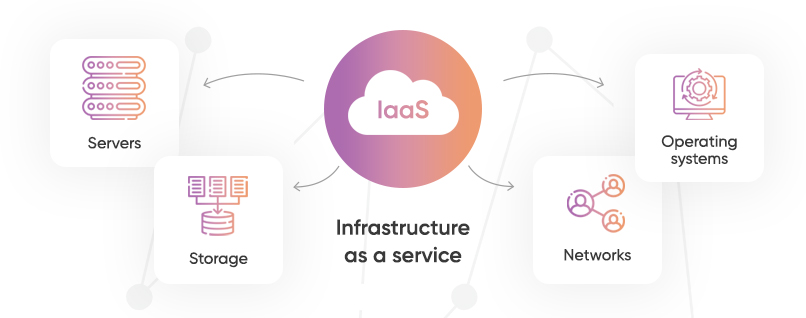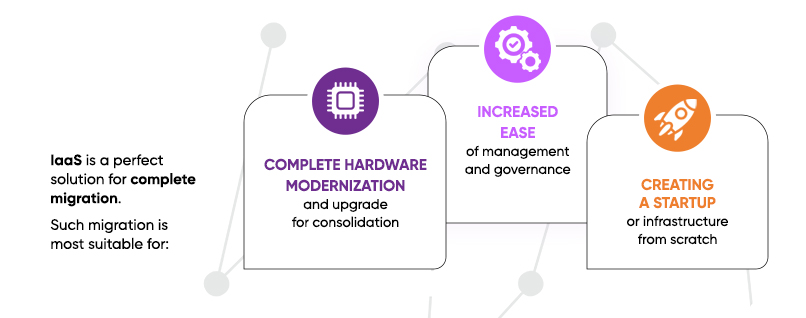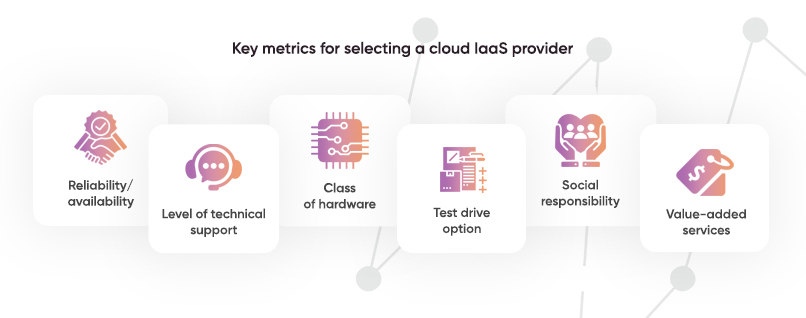Contents
European providers offer clients a variety of services, including the most flexible IaaS model. In this case, it is a complex provision of infrastructure as a service, which includes the entire computing infrastructure (servers, storage, networks, and operating systems) that clients require to implement their own software solutions.
 When selecting a provider, clients are most often looking for the optimal solution for a specific issue. For example, they need cloud backup, Disaster Recovery service for asynchronous replication and quick recovery after crashes or failures. Sometimes clients are looking for additional infrastructure and services just to be on the safe side, if even the slightest business downtime can lead to major problems.
When selecting a provider, clients are most often looking for the optimal solution for a specific issue. For example, they need cloud backup, Disaster Recovery service for asynchronous replication and quick recovery after crashes or failures. Sometimes clients are looking for additional infrastructure and services just to be on the safe side, if even the slightest business downtime can lead to major problems.
In some cases, IaaS is a perfect solution for complete migration and optimization of infrastructure, especially siloed infrastructure, on a single site (with the subsequent possibility of building distributed infrastructure in an additional site). Such migration is most suitable for a complete hardware modernization and upgrade for consolidation, increased ease of management and governance, as well as for creating a startup or infrastructure for companies from scratch. For a trouble-free move to an IaaS provider, it is necessary to study the offered conditions in advance and compare them with the offers of other service providers.

The provider allocates a group of servers or racks with the necessary network hardware and software, other hardware, etc. at the client’s request. When connecting to the company – IaaS provider, it is not necessary to completely migrate to the cloud. For example, highly loaded services, for which availability is an important requirement, can migrate, while business applications or individual infrastructure elements can remain on the hardware.
Cloud infrastructure as a service is a provider’s transfer of a pool of IT resources for the client’s business task. The provider is the owner of physical IT hardware, on the basis of which he offers to rent out a powerful and high-performance infrastructure.
Business benefits of IaaS cloud services
Advantages:
- Costs optimization, reduction of capital investments (there is no need to purchase and place server hardware in a special room, configure it, maintain its operability, upgrade it, be responsible for its security, and dispose of it). The cost of personnel responsible for the operation of the “hardware” component of the infrastructure is slightly reduced.
- Tax savings, as virtual infrastructure is included in the cost of the company’s services. In this case, the services act as operating costs, which results in lower taxation.
- Rented IT infrastructure is suitable for deploying and running any IT solutions.
- Increased performance of highly loaded applications.
- Reliability and stability of hardware and software are entrusted to the service provider.
- The number of instances involving human factor interference in the operation of the infrastructure is minimized.
- Provider controls physical hardware.
Disadvantages of IaaS model:
- The quality of service depends on the level of reliability of the provider.
- Dependence of end clients on the quality of Internet connection (in a data center the Internet is received from a large number of providers. But if the client is remote, for example, his office is in Egypt and the provider is in Australia, the connection may have delays that exceed the acceptable norms for stable operation).
Typical IaaS scenarios
- Lift-and-shift application migration without refactoring the underlying architecture.
- Scaling environments for testing and application development.
- Planning and management of data storage, archiving and recovery systems.
- Deployment of web applications and network resources with dynamically scaled infrastructure.
- Running high-performance computations with millions of variables (e.g., financial modeling).
- The company has high security requirements, uses crypto-protection and encryption systems. When renting infrastructure as a service, the client receives hardware from the provider, then installs its own virtualization, virtualization management, monitoring, software, and ERP systems on it. In other words, the client rents resources, but continues to work within its own, pre-built threat model.
IaaS services are in demand by companies for which:
- fluctuations in the load on IT resources are inherent (as in the case of retail);
- there are no funds available to purchase physical hardware, but there is a need to develop or quickly shut down the project (relevant for new, fast-growing business areas);
- the issue of additional capacity needs to be resolved quickly (within a few hours or days);
- it is important to reduce operational costs by moving part of the systems to the cloud;
- isolated capacities are required for testing hypotheses or conducting experiments (including under load).
By purchasing cloud infrastructure as a service, the client gets access and independent management of virtual resources: servers and storage. In this case, the provider guarantees the physical security of the data center, provides global fault tolerance and protection of the cloud infrastructure. The client is independently responsible for the security of rented virtual resources, purchases, installs and configures its own software and manages it.
![]()
![]()
Selecting the best IaaS provider in Europe: primary considerations for optimal solutions
When it comes to selecting cloud as a service, most users don’t go into the technical nuances. In this case, they are secondary, the positive emotions of real clients and the level of service determined by the customer experience come first.
As a rule, inquiry starts with ratings and monitoring reviews of the biggest/best European IaaS providers. A potential client is interested in basic aspects, such as the level of qualification and friendliness of technical support, quality of service and convenience of interaction.
Clients are looking for both direct and indirect information. For example, important criteria may include the duration of the provider’s presence in the market, the location of data centers (for example, for some people, speed and stability of response are crucial, so they select a data center located in a major European Internet hub), the schedule of technical support, network connectivity between major cloud providers, discounts for connecting cloud infrastructure as a service, fixing the cost when paying for a period of three years or more, and so on.
For their part, providers, knowing how burdensome the migration process can be, strive to offer the most flexible and transparent terms of cooperation (for example, they assume all risks and guarantees or fix prices when concluding contracts for 1-3 years), so that clients are focused on long-term cooperation.
We analyzed more than two dozen European providers offering equivalent services, took into account the functionality and benefits of each offer, studied reviews and ratings, put together more than a dozen metrics that are used to select the most suitable IaaS provider for the client’s tasks.

-
Reliability/availability/fault tolerance guarantees
The reliability criterion must be at least TIER III level (a requirement met by most data centers). This means that services are hosted by the cloud provider without risk of downtime and financial loss (in case of accidents and failures, the consequences are eliminated as soon as possible, the client does not have time to notice anything).
-
Service Level Agreement
Fixes the boundaries of the provider’s responsibility and the terms of service provision. Impeccable SLA compliance means that uptime is 99.999% and the team immediately handles requests 24/7/365 for any issue related to the client’s IT infrastructure. It is imperative to see that the contract spells out compensation options in the event of failure to fulfill commitments.
-
Level of technical support
Technical support is the face of the provider, an indicator of its interest in clients. It has high requirements in terms of responsiveness, friendliness, lack of bureaucracy, and ability to work with different clients. For example, it is easier for a client to communicate in his native language, so a number of providers meet his needs and offer service in English, German, Spanish, regardless of the country where the data center is located. To make the client feel comfortable, technical specialists provide various communication options, including messengers.
The largest IaaS providers often have branches in different countries, so clients have to conduct numerous negotiations with different managers in the process of problem solving. This is what makes it attractive to have a personal manager capable of solving, among other things, engineering issues. For those who have already experienced the chain of communication with technical staff, redirecting the client to each other, or engineering specialists working on the ticket system (they have to explain even a cyclic issue “from scratch” every time) – the benefit is clear. An attached manager is familiar with the specifics of the client’s business, the peculiarities of its infrastructure, and typical reasons for requests. He is ready to solve tasks quickly, acting as a representative of the project team. If a problem is solved promptly and with minimum costs when contacting the account manager, the client will consider this to be the best IaaS provider for him.
-
Class of hardware
When deploying corporate services, you should clarify what class of hardware is used by the service provider. Enterprise solutions minimize hardware issues. Also, the cloud platform should not have a common point of failure so that any component failure does not affect application performance.
-
Test drive option
Before deciding to migrate to a new cloud IaaS provider, you should ensure that the cloud infrastructure is performing well and that the service provider is meeting its commitments. To do this, you should test your virtual infrastructure for one to two weeks with test loads of resource-intensive applications at different times of the day.
-
Social responsibility
Responsible data centers not only take care of their clients, but also pay attention to energy efficiency, environmental friendliness, implementing green technologies and using electricity from renewable sources. For example, the EkoBasis product certified by the German expert organization TÜV SÜD, which is safe for people, environment and assets from technological risks, can be used as a source of electricity. Among other things, to assess the level of responsibility, the company should pay attention to participation in charitable activities.
Infrastructure as a service: how to select a cloud IaaS provider in Europe
Write us a message to get additional information.
or book a free consultation
If a client comes to a provider selecting infrastructure as a service, it doesn’t mean that the client doesn’t have other needs. The task of a responsive and client-oriented technical staff is to understand how to help the client solve his business issue. Not to impose unnecessary services, but to consult, to offer really useful solutions, to shift some of the client’s concerns onto their own shoulders. As a rule, clients highly appreciate such care and do not tend to start searching for “their” IaaS service provider again.
You can contact our IaaS technology specialist for a free consultation on a selection of European providers, including those in Germany, offering Infrastructure as a Service.
Article author Olga Boujanova Consultant on server hardware, network and cloud technologies
